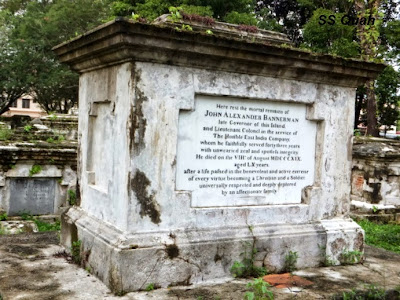Sunday, 27 October 2013
Protestant cemetery
I was at the old Protestant cemetery in Northam Road, George Town, Penang, recently and this is the grave of the Revd Robert Sparke Hutchings, founder of the Penang Free School, which celebrated its 197th anniversary on the 21st of October 2013.
This year also marks the nonagintennary of The Old Frees' Association (If you don't know what "nonagintennary" means, go figure it out yourself. I also had to look it up, haha....) and the golden anniversary of the present OFA building in Northam Road. The association was established in 1923 by a group of Old Boys and we have been carrying on with the proud tradition of fraternising with fellow Old Frees ever since. In 1963, the present premises was declared open by the previous Raja of Perlis who also happened to be the Yang Di-Pertuan Agong at that time.
And to cap up a rather magical moment on Monday, the 21st of October was also the anniversary date of Francis Light's death. It is to be noted that Light was a sea-faring captain and was never knighted by any British monarch.
Capt Francis Light, the man who established the Prince of Wales Island as a trading post for the East India Company in 1786 and became its first Superintendent, died on 21 Oct 1794 itself (and not 25 Oct 1794 as erroneously reported in wikipedia and elsewhere that chose to copy this mistake without verifying.) This is his grave at the Protestant cemetery.
I found two other references or sources to support this date of Light's demise. The first is the marble slab in the canopy at the grounds of the Church of St George the Martyr in Farquhar Street, George Town, which had this dedication that read: "In Memory of Francis Light Esq who first established this island as an English Settlement and was many years Governor born in the County of Suffolk in England and died October 21st 1794"
The second was a 141-page book, A Short Sketch of the Lives of Francis and William Light by Archibald Francis Steuart, which was published in 1901 by Sampson Low, Marston & Company of London.
On page 33, Steuart wrote: "At the commencement of the settlement the colonists were surprised by the absence of fever, but in 1787 the superintendent was struck down with a malarial attack. In 1794 he was seized by another malarial fever. He was able to dictate a will on the 20th of October, but succumbed on the following day, to the great grief of his friends and of the islanders."
I did not have time to walk all around the whole cemetery as I had to rush to the Penang Free School for their Speech Day, but I did manage to locate a few graves of several notable early pioneers of the Prince of Wales Island, such as:
John Alexander Bannerman was the sixth Governor of the Prince of Wales Island. He died on 8 Aug 1819.
William Petrie was the fifth Governor of the Prince of Wales Island. He died in office on 26 Oct 1816.
James Scott was Francis Light's business partner. He died on 19 Sep 1808. I still have doubts whether or not Scott acted fairly for Light's widow, Martina Rozells, in the execution of Light's will.
James Richardson Logan was a prominent lawyer and an early human rights supporter. He died on 20 Oct 1869.
And of course, the grave of Thomas Leonowens, a person of almost anonymous status if not for the fact that his widow, Anna, later went on to become a Royal Governess for six years in the court of Mongkut, King of Siam. Think Thomas Leonowens, think of The King And I.
Subscribe to:
Post Comments (Atom)









2 comments:
Matters are not so clear cut. There are references which are quoted regarding the date of death in the Wiki article on Francis Light. It was also mentioned that the date of death as shown on the tombstone was 21st October. Your book source does not seem so convincing. Perhaps an academic historian should be consulted?
Hi, anybody can write anything on Wiki, and it is easy for anyone to login and edit the entries there. I've seen information in Wiki that are spurious. As such, Wiki cannot be accepted as the ultimate truth. Anyway, what can be more accurate than the information on the tombstone or the church memorial which were erected by the family or parishioners? They were literally carved in stone. :-)
Post a Comment